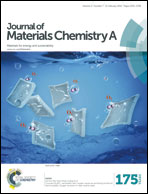Highly efficient macroporous adsorbents for toxic metal ions in water systems based on polyvinyl alcohol–formaldehyde sponges†
Abstract
A series of macroporous adsorbents based on polyvinyl alcohol–formaldehyde (PVF) sponges was prepared using redox-initiated grafting polymerization of acrylamide (AM) followed by hydrolysis under alkaline conditions. The as-prepared sponges display average pore sizes in the range of 60–90 μm and interconnected pores with a porosity of approximately 90%. Elementary analysis confirmed that the amide groups in AM grafted PVF (PVF-g-GAM) have been rapidly converted into sodium carboxylate and the hydrolysis degree (HD) reaches approximately 65.5% within 6 h. The PVF-g-GAA (hydrolyzed PVF-g-GAM) sponges possess excellent water absorption performance with the ability to reach water absorption equilibrium within a few seconds and a saturated absorption capacity more than 300 g g−1. Importantly, the PVF-g-GAA can be used as adsorbents to remove toxic metal ions, such as Cu2+, Pb2+ and Cd2+, in wastewater efficiently due to the existence of abundant carboxylate groups in the abovementioned network. In single metal ion systems, the sponges could reach adsorption equilibrium within 10 min and the adsorption kinetics fit well with a pseudo-second order kinetic equation. The influence of pH and types of metal ions on the adsorption capacities have also been investigated extensively. PVF-g-GAA-20 displays high adsorption performances with maximum adsorption capacities for Cu2+, Pb2+ and Cd2+ up to 2.50, 3.20 and 3.15 mmol g−1 at pH 5.11, respectively. The equilibrium adsorption isotherm demonstrated that the adsorption equilibrium of the PVF-g-GAA-20 for Cu2+, Pb2+ and Cd2+ ions follows the Langmuir isotherm model very well with maximum adsorption capacities approximately 4.00, 3.97 and 3.34 mmol g−1, respectively. In the binary metal ion coexistence systems, including Cu2+/Pb2+, Cu2+/Cd2+ and Pb2+/Cd2+ mixtures, PVF-g-GAA-20 displayed excellent absorption selectivity for Cu2+ and Pb2+ and the values of  and
and  were 13.4 and 7.14, respectively. It can be noted that the adsorption capacities for the abovementioned three metal ions slightly decreased with the variation of ionic strength in the range of 0.01–0.08 M. The sample also exhibited a quick desorption procedure of less than 10 min and excellent reusability of atleast six re-cycles. The adsorption mechanism was also discussed. The PVF-g-GAA sponges are definitely ideal adsorbents for removing/separating toxic metal ions in waste/polluted water bodies.
were 13.4 and 7.14, respectively. It can be noted that the adsorption capacities for the abovementioned three metal ions slightly decreased with the variation of ionic strength in the range of 0.01–0.08 M. The sample also exhibited a quick desorption procedure of less than 10 min and excellent reusability of atleast six re-cycles. The adsorption mechanism was also discussed. The PVF-g-GAA sponges are definitely ideal adsorbents for removing/separating toxic metal ions in waste/polluted water bodies.


 Please wait while we load your content...
Please wait while we load your content...